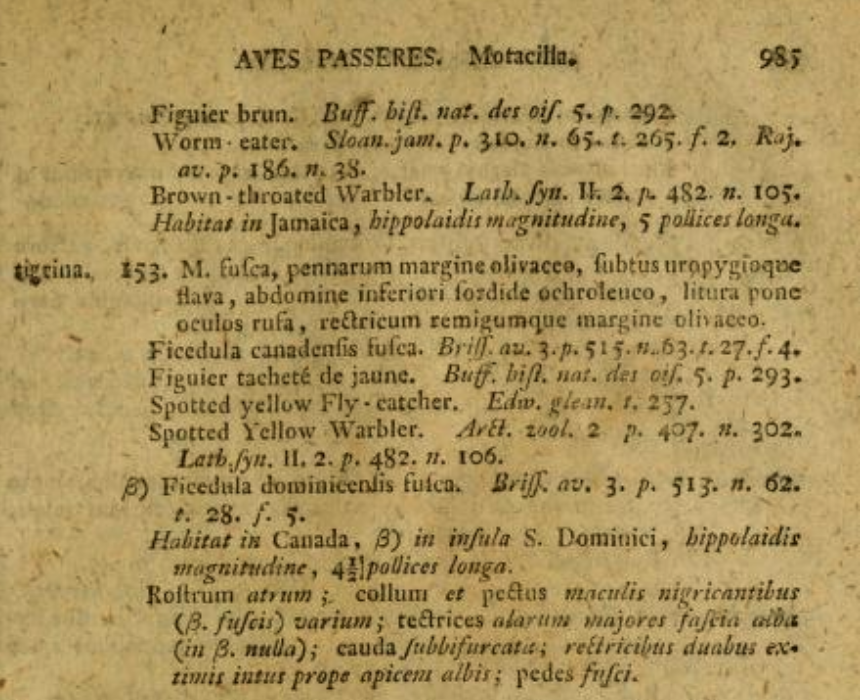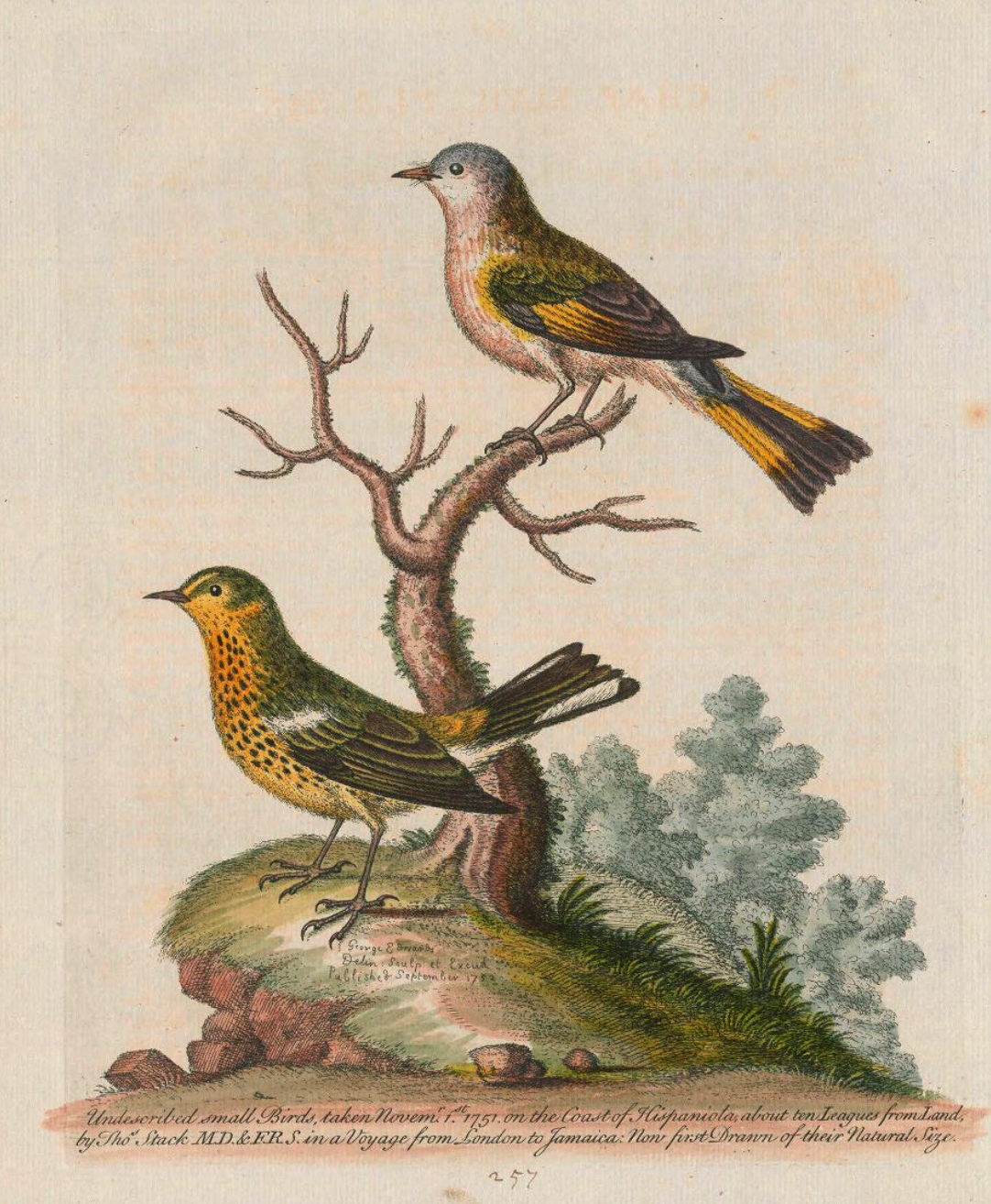
I have always liked the Cape May Warbler. The male in spring is a handsome bird, but scarce enough here in eastern Ontario that I see only one or two every spring [1]. When I first saw one on migration at Long Point Bird Observatory in the 1960s, my friend and mentor David Hussell said that it was really a misnomer—the species was originally collected on Cape May, NJ, he said, but had hardly ever been seen there since.
There are only three other North American birds named after such a small region of the continent [2], and the others are also misnomers in the sense that they do not represent anything useful about the bird’s range, habitat, appearance or song [3]. While there are rules about priority in the assigning of scientific names to species, common names are largely at the whim of the first person to describe the species, and, in North America, the later machinations of the AOU Check-list committee (now AOS’s North American Classification Committee).
That ‘first’ Cape May Warbler was a male collected by George Ord on a collecting trip with Alexander Wilson on Cape May in May 1812 [4]:
THIS new and beautiful little species was discovered in a maple swamp, in Cape May county, not far from the coast, by Mr. George Ord of this city, who accompanied me on a shooting excursion to that quarter in the month of May last…The same swamp that furnished us with this elegant little stranger, and indeed several miles around it, were ransacked by us both for another specimen of the same; but without success. Fortunately it proved to be a male, and being in excellent plumage, enabled me to preserve a faithful portrait of the original. [5]
Wilson described the bird, painted it (see above), and called it the Cape May Warbler Sylvia maritima in Volume 6 (page 99) of his American Ornithology, published in 1812. It was not seen again on Cape May until September 1920 when Witmer Stone found it there but it has been increasingly recorded—and is now regularly seen—on Cape May during migration ever since [6].
Unbeknownst to Wilson, the bird had already been described as Motacilla tigrina in 1789 in Johann Friedrich Gmelin’s edition of Linaeus’s Systema naturae:

But wait, Gmelin says that this is the same species as Brisson’s Ficedula canadensis fusca and F. dominicensis, Buffon’s ‘Figuier tacheté de jaune,’ Edwards’s ‘Spotted Yellow Flycatcher,’ and Pennant’s (1874) ’Spotted Yellow Warbler.’ OK, Buffon, Edwards and Pennant did not give it a scientific name, and Brisson’s F. canadensis is the Chestnut-sided Warbler and his F. dominicensis is the Mangrove Warbler. So Gmelin is considered to be the scientific naming authority for this species, and the species name he gave it, tigrina, is official. He also correctly identified the habitat as ‘Canada’, presumably based on Pennant who said “Inhabits also Canada, which may be its place of summer residence and breeding.” [7]
But how did Gmelin (and the others) who wrote in 1789 even know about this species if the ‘first’ specimen was the one collected by George Ord on Cape May in 1812? The short answer is that Wilson was mistaken, as was Charles Lucien Bonaparte who later wrote about Wilson’s nomenclature [8] and edited editions of Wilson’s American Ornithology after Wilson died in 1813. Since Gmelin, Brisson, Buffon and Pennant were all referring to Edwards’s specimens, Gorge Ord’s warbler was actually the third specimen of what we now call the Cape May Warbler.

The first specimen of what we now call the Cape May Warbler was actually collected on 1 November 1751 when a male and female landed on a boat about 56 km off the coast of the island of Hispaniola in the Caribbean. George Edwards obtained the specimens and published his painting of the male in 1758 on a plate with an American Redstart (shown to the right). In the plate caption [9], Edwards says these “undescribed small Birds” were collected by Thomas Stack “in a voyage from London to Jamaica.” Of the female, Edwards says: “the breast in the hen was of a dirty yellow white spotted with dusky, and something less bright on the back; otherwise they are marked very much alike. These birds I believe have never been figured or described until now.” [10]
I have actually always liked the name ‘Cape May Warbler.’ Even though that moniker does not tell us anything useful about the bird, the name has an interesting history, in the same way as the name ‘Lady Ross’s Turaco’ that I wrote about in a previous post. And it’s much better than Boat-off-the-coast-of-Hispaniola Warbler, or Spotted Yellow Fly-catcher.
SOURCES
- Bonaparte CL (1826) Observations on the Nomenclature of Wilson’s Ornithology. Philadelphia: Anthony Finley.
- Brisson M-J, Martinet FN (1760) Ornithologie, ou, Méthode contenant la division des oiseaux en ordres, sections, genres, especes & leurs variétés (t.1 (1760)). Parisiis :Ad Ripam Augustinorum, apud Cl. Joannem-Baptistam Bauche, bibliopolam, ad Insigne S. Genovesae, & S. Joannis in Deserto.
- Burtt Jr EH, Davis Jr WE (2013) Alexander Wilson: The Scot Who Founded American Ornithology. Cambridge, Mass.: Harvard University Press.
- Edwards, G (1758) Gleanings of Natural History. Part I. London: Printed for author at the Royal College of Physicians.
- Gmelin JF (1789) Caroli a Linné. Systema naturae per regna tria naturae : secundum classes, ordines, genera, species, cum characteribus, differentiis, synonymis, locis. (Tom. 1 Pars. 2). Lipsiae: impensis Georg. Emanuel. Beer.
- Pennant T (1784) Arctic Zoology, 2 vols. London: Henry Hughs.
- Wilson A (1908-1914) American Ornithology; or, the natural history of the birds of the United States. Vols I-IX. Philadelphia: Bradford and Inskeep. Available here.
Footnotes
- Rarity of Cape May Warbler in eastern Ontario: ebird says I am not alone as almost all sightings within 100 km of where I live in Kingston, Ontario, are of 1 bird on a given day.
- Area of Cape May: depending on how you measure it, Cape May is no more than 50 km2
- Three other North American bird misnomers: Nashville Warbler also named by Wilson in 1811 based on a specimen he collected on migration near Nashville—the bird breeds in the boreal forest of eastern Canada and northeastern USA, as well as in the mountains from BC to California; Philadelphia Vireo named in 1851 by John Cassin based on a bird collected on migration in Bingham’s Woods near Philadelphia where he lived and worked—the bird breeds mainly in Canada from British Columbia to Newfoundland; and the Key West Quail-dove which did once breed in the Florida Keys (including Key West) but is now just a vagrant in Florida having been extirpated as a breeder there in the 1800s—the bird was described by Charles Bonaparte in 1855 based on a specimen from Key West but that was even then the very northern tip of its breeding range that encompasses the Greater Antilles and the Bahamas.
- Collected in 1812: since Wilson was writing in the summer of 1812, Burtt and Davies (2013) interpret ‘May last’ as meaning May 1812, but Ord later claimed that the bird was shot in May 1811, possibly as an attempt to show that his bird was collected before a bird that Audubon thought might be the same species. Audubon collected his bird in Kentucky in May 1811, and called it the Carbonated Warbler. See Burtt and Davies (2013 page 341) for further information on this.
- Quotation from Wilson: 1812 (vol 6), page 99
- Sightings on Cape May: ebird, for example, shows more than 100 sightings since 2011.
- Quotation from Pennant: 1784 page 407. Pennant actually called it the Spotted Warbler and not the Spotted Yellow Warbler as Gmelin claimed.
- Bonaparte’s nomenclature: see Bonaparte 1824, page 14
- Edwards’s plate: is numbered ‘257 and appears between pages 100 and 101 in Edwards (1758)
- Quotation from Edwards: 1758 page 102
IMAGES: all from digital copies of the books in the Biodiversity Heritage Library, in the public domain
COMMENTS